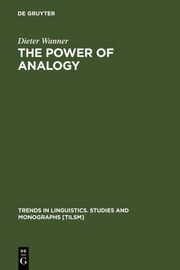-
Zusatztext
-
In The Power of Anology, Dieter Wanner argues for reinstating historical linguistics, especially in (morpho-)syntax, as constitutive of any theoretical account of language. In the first part, he provides a critique of some foundational concepts of an object-oriented linguistic perspective, questioning the distinction between synchrony and diachrony, dichotomous parametrization, grammaticality judgments, and formal generalization. Instead, the immanent perspective of the linguistic individual, licensed by broad cognitive functions, highlights such relegated dimensions as similarity, (surface) redundancy, frequency of form, and social and environmental conditions on language use. In the second part, Dieter Wanner relies on a systematic construct of analogy as the dynamic force enabling language, tying together acquisition, language use, and linguistic change. Such analogy is pervasive, driven by local models, and inevitably spreading through the social web of linguistic practice. The unpredictability, incompletion, and typical slowness of change thereby become the norm, while categorical closure remains a marked possibility. The framework of "Soft Syntax" spells out an operative model for syntax relying on precedence, cohesion, dependence, agreement, constructional identity, and concatenation. These six dimensions and their interplay undergo a detailed exploration of their diachronic operation and implications, applying them to typical examples taken from the history of the Romance languages. The openness of the framework enables diachronic linguistics to approach old problems in a new light and to ask new questions about the mechanics and nature of language change.
-
-
Kurztext
-
The series publishes state-of-the-art work on core areas of linguistics across theoretical frameworks as well as studies that provide new insights by building bridges to neighbouring fields such as neuroscience and cognitive science. The series considers itself a forum for cutting-edge research based on solid empirical data on language in its various manifestations, including sign languages. It regards linguistic variation in its synchronic and diachronic dimensions as well as in its social contexts as important sources of insight for a better understanding of the design of linguistic systems and the ecology and evolution of language.
-
-
Autorenportrait
- Dieter Wanner, Ohio State University, Columbus, USA.
Detailansicht
The Power of Analogy
An Essay on Historical Linguistics, Trends in Linguistics. Studies and Monographs [TiLSM] 170
ISBN/EAN: 9783110188738
Umbreit-Nr.: 1776733
Sprache:
Englisch
Umfang: XV, 330 S.
Format in cm: 2.4 x 23.5 x 16.5
Einband:
Leinen
Erschienen am 19.05.2006
Auflage: 1/2006


